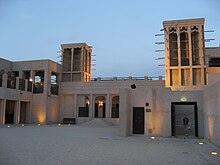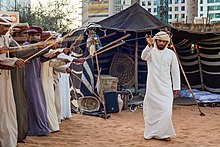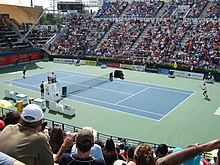United Arab Emirates Muslim Culture in America High School Art

The Culture of the United Arab Emirates is part of the culture of Eastern Arabia.[1] Its historical population was a pocket-size tribal community that changed with the arrival of an influx of foreign nationals in the mid-20th century.[ii] Emirati culture is a blend of Arabian, Islamic, and Persian cultures, with influences from the cultures of East Africa and Indian Subcontinent.[3] Islam has had a prominent influence on local architecture, music, attire, cuisine, and lifestyle.[4]
In the United Arab Emirates, the urban center of Al Own in the Emirate of Abu Dhabi is a UNESCO World Heritage Site.[5] The Emirate of Sharjah was named "The Cultural capital of the Arab World" past UNESCO in 1998 and the "Capital letter of Islamic Culture for 2014" past the OIC.[half-dozen]
History [edit]
Artifacts uncovered in the UAE show a history of man habitation, transmigration and trade spanning over 125,000 years.[seven] The area was previously home to the Magan people[viii] known to the Sumerians, who traded with both coastal towns and statuary miners and smelters from the interior. A rich history of trade with the Harappan culture of the Indus Valley is likewise evidenced by finds of jewelry and other items and there is likewise extensive early bear witness of trade with Bactria[9] as well as the Levant.[ citation needed ]
Historically, people who are today called Emiratis were called Trucial Coasters [10] or Trucials in the medieval era.[11] In the ancient period, Emiratis were referred to as Maganites.[12] Due to potent tribal allegiances, many Emiratis self-place by their tribal affiliations, especially if they come from an influential tribe.[13]
Standard arabic civilization [edit]
The UAE'south official linguistic communication is Arabic, but English language is widely spoken due to the country's diverse nature and economic globalization.[14] [15] [16] Farsi, Hindi, Urdu, Bengali and Mandarin are also widely spoken by expatriates from Iran, Republic of india, Pakistan, People's republic of bangladesh, and China.[17] [eighteen] [19]
Native Emirati nationals speak the Gulf Standard arabic, which is like to that spoken in other GCC countries and Iraq.[15] [20] [21]
Naming Conventions [edit]
The first name is followed past "ibn" or "bint," which ways 'son of' or 'daughter of', respectively, and the name of the father followed by the family name.[17]
After marriage, women retain their family unit names, and children take the name of the male parent.[22]
Architecture [edit]

Sheikh Maktoum house courtyard featuring the mutual compages of wind-catchers called Barjeel.
The United Arab Emirate'south architecture is influenced by Islamic architecture and Arabian architecture.[23] For example, the "barjeel" has become an identifying marker of traditional Emirati compages and is attributed to Persian influence.[3]
Emirati architecture reflects the traditional lifestyles and community of the people. Building materials are elementary, but well-adapted to local living and climate. For migrant tribes, portable tents traditionally provided shelter during the wintertime flavour. Inland, more permanent houses were built of stone guss with roofs made from palm tree leaves. Fossilized coral, cut in blocks, bonded with sarooj or a seashell-derived lime mixture, and plastered with chalk and water paste, was used extensively in littoral regions.[24]
A courtyard architectural layout was unremarkably seen in the colloquial architecture of the UAE such as houses, schools, mosques, and governmental buildings. The courtyard was a thermal regulator in hot and humid weather merely also had privacy functionality. Privacy and ventilation are important components in traditional architecture of the UAE.[24]
Lifestyle [edit]
Vesture [edit]

An Emirati folk dance, the women flip their hair sideways in brightly coloured traditional apparel.
Many Emirati men and women prefer traditional Emirati wearing apparel; the kandura and abaya.[25]
Traditional clothing is designed for comfort in high temperatures and to keep with the Islamic religious behavior in the country. Vesture that cover more parts of the torso from the sunlight is preferred.[26] [27] Ballgowns are common in this area. Ballgowns are comonly adorned with silverish and gold. [28]
Colourful embroided dressing is mutual during occasions such equally weddings or dancing. A mutual dance in the Gulf Arab countries is the Khaleeji folk dance which entails rows of women in close proximity to one another who move in a slow fashion while rhythmically swaying their pilus from side to side. The dress is an important attribute of this trip the light fantastic.[29]
Cuisine [edit]
The Emirati diet is a mixture of a Bedouin diet (meat and camel milk), a fishermen'south nutrition (fish), and a farmer'due south diet (dates). These foods, along with key spices, such equally cinnamon, saffron, and turmeric, form the basis of both historical and modern Emirati cuisine.[30]
Vegetables that are piece of cake to grow, such as cucumbers and tomatoes, are featured prominently in the diet. Stale lemons, chosen loomi, are grown locally and used in numerous dishes. Mangos are also grown in the northern emirates. Meats traditionally used include chicken or minor fowl, such as Houbara bustards, and goats. Since camels are highly prized for milk and as a means of transportation, camel meat is normally reserved for special occasions.
Muslims do non eat bacon, ham or pork, and they practice not drink alcoholic beverages.[31] [32]
Popular dishes include harees, fouga, kabsa and luqemat. Common Middle Eastern cuisine is also widely available. Due to the cosmopolitan nature of the United Arab Emirates, the almost pop street-side snack is the Middle-Eastern shawarma.[33]
One of the best national dishes is stuffed camel cooked slowly over a pit of burning charcoal.[32] Harees is likewise a national specialty; it is a porridge-like dish often served in Ramadan or during large celebrations like weddings. It is made with wheat, meat (or chicken) and salted water.[34]
Greetings and social customs [edit]

When inbound a Majlis, guests volition start greeting individuals from the right side to the left side of the room, unless at that place is an elderly guests, who should be greeted starting time. For men, the traditional Emirati greeting is the khushmak, or touching of noses. Women greet each other by shaking hands and giving a osculation on the cheek. Kissing the top of the head is likewise a common way of greeting in the UAE.[35] Members of the opposite sexual activity should not embrace unless they are closely related.[17]
Afterward greeting guests, the host serves Emirati Coffee to the guests starting from the right side of the room and moving their fashion to the left of the room, it is also mutual for the host to serve the elderly guests showtime or an important guest in the room. It is also function of the Emirati social custom for the person serving java to hold the java pot "dallah" in their left hand and serve the coffee loving cup to the invitee using their right paw. In a male gathering, the person serving the java will remain continuing until the invitee shakes their coffee loving cup to point that they do not want a refill, while in a female gathering, the adult female serving the coffee is immune to sit while serving others coffee. Less than half the java cup should be filled and the coffee beingness served should be hot to bespeak to the invitee that the java was specially made for them. For the guests, the coffee cup is taken with their right hand and given back using their right hand once done.[35]
Literature and verse [edit]
Themes in Emirati poetry are diverse, ranging from satire, cocky-praise, and patriotism, to chivalry, religion, family unit, and love.[36] [37] [38]
As in many other Arab countries, poetry is considered a key fine art course. Traditional forms persist today, although some Western styles of prose poesy accept gained popularity.
The first Emirati novel, Shahenda, was written by Rashid Abdullah Al Nuaimi.[39]
Contemporary literary figures include Nujoom Al-Ghanem, Ousha Al Sha'er, Khalid Albudoor, and Aisha Al Kaabi.
Music, trip the light fantastic, and film [edit]

A ring performs the Ayyala, which is a cultural dance derived from Arab tribes sword battles.
The United Arab Emirates is a office of the Arab khaleeji tradition. Yowlah is a type of music and trip the light fantastic toe performed mainly in communities of Bantu people from the African Corking Lakes region.[40] One of the UAE's most famous traditional singers is Mehad Hamad, who is known for singing patriotic lyrics and poems about the desert.[41] [42]
Many traditional songs and dances, handed down from generation to generation, have survived to the present time. Young girls would dance by swinging their hair, which was traditionally worn long, and swaying their bodies. Men often re-enacted battles or successful hunting expeditions using a weapon trip the light fantastic toe; such every bit the Yowlah.[43]
Sports [edit]

Football is the most pop sport in the UAE. Emirati football clubs Al-Own, Al-Wasl, Al Nasr, Al-Sharjah, Al-Wahda, and Shabab Al-Ahli are the most popular teams and bask reputations as long-time regional champions.[44] The UAE national football team qualified for the FIFA Globe Cup in 1990 along with Egypt. Information technology was the 3rd consecutive Globe Cup with two Arab nations qualifying, after Kuwait and People's democratic republic of algeria in 1982, and Iraq and Algeria again in 1986.[45] The UAE likewise won the Arabian Gulf Cup held in Abu Dhabi in Jan 2007.[46]
Cricket is i of the almost popular sports in the UAE, largely due to the departer population from the Indian subcontinent. At that place are 3 International Cricket stadiums in UAE. They accept hosted many international cricket matches such every bit one T-20, 2014 IPL, and many more.[ description needed ]
Brazilian Jiu-Jitsu is too increasing in popularity within the UAE. Both the developed team and the juvenile team oftentimes compete and win events both locally and internationally.[ citation needed ] The World Pro Abu Dhabi tournament attracts hundreds of competitors annually and features a large cash prize. Brazilian Jiu-Jitsu as well features prominently in local Abu Dhabi school curricula.
Inhabitants of Arab States of the Persian Gulf have enjoyed camel racing for many years as it is considered a traditional sport.[47] Formalizing camel racing was one way of maintaining its central role in UAE life. In the past, UAE had a reputation for exploiting South Asians equally jockeys.[48] However, robot jockeys are now used later strict regime regulations were passed prohibiting underage jockeys from racing.[49]
The UAE now has no fewer than 15 race tracks across the vii emirates. Nad Al Sheba Racecourse, x kilometers outside of Dubai, Al Wathba, thirty kilometers southward-east of Abu Dhabi, and Al Ain rail, which is 20 kilometers west of Al Ain, are all large, well-equipped camel tracks with high-tech facilities. Ii smaller tracks are located in Sharjah, one in Ra's al-Khaimah and one in Umm al-Qaiwain. Others are spread throughout the desert areas.[fifty]
In 2021, the UAE formed its starting time ever all-female camel racing team.
Other popular sports include auto racing, falconry, endurance riding, and tennis.[51]
Holidays [edit]
Major holidays in the UAE include Eid ul-Fitr, which marks the cease of Ramadan, Eid Al-Adha and Arafah Day, both of which historic during the Hajj period, the UAE National Mean solar day on December 2 and 3, which marks the germination of the United Arab Emirates, New year on January the 1st, Commemoration Day on November xxx to laurels those who died fighting for the UAE, the Islamic (Hijri) New year, and the Prophet's Altogether (Mawlid).[52] [53]
| Appointment | English | Standard arabic | |
|---|---|---|---|
| January 1 | New Yr's Mean solar day | Ra's as-Sana al-meladiah | رأس السنة الميلادية |
| Zil Hajjah ten | Solar day of the Cede | Eid-al-Adha | عيد الأضحى |
| Muharram ane | Islamic New year's day | Ra's as-Sana al-Hijria | رأس السنة الهجرية |
| Rajab 27 | The Nighttime Journey | Al-Isra'a wal-Mi'raj | الإسراء والمعراج |
| Dec ii | National Day | Yawm al watani | اليوم الوطني |
| Ramadan 29/thirty Shawwal ane | End of Ramadan | Eid-ul-Fitr | عيد الفطر |
See also [edit]
- Cultural Policy in Abu Dhabi
- Demographic of the United Arab Emirates
- Tourism in the United Arab Emirates
References [edit]
- ^ "Land and Metropolitan Stats in Brief. MPI Data Hub
- ^ Jones, Jeremy (2007). Negotiating Change: The New Politics of the Middle East. Jeremy Jones. pp. 184–186. ISBN9781845112707.
- ^ a b Hurriez, Sayyid Hamid (sixteen Dec 2013). Folklore and Folklife in the United Arab Emirates. p. 167. ISBN9781136849077.
- ^ "Culture of UAE - Traditions, Cuisine, Architecture, Customs & More". world wide web.holidify.com . Retrieved 2022-01-15 .
- ^ Al Ain, a UNESCO Earth Heritage site.
- ^ "Civilization - The Official Portal of UAE Government". Retrieved 2016-06-30 .
- ^ "Early human may have left Africa earlier | Homo Globe | EarthSky". earthsky.org. 2011-02-01. Retrieved 2021-08-ten .
- ^ "Earthworks in the State of Magan - Archaeology Mag Archive". annal.archaeology.org . Retrieved 2021-08-ten .
- ^ United Arab Emirates : a new perspective. Ibrahim Abed, Peter Hellyer. London: Trident Press. 2001. ISBN1-900724-47-2. OCLC 47140175.
{{cite book}}: CS1 maint: others (link) - ^ Winder, Bayly (1965). Saudi Arabia in the Nineteenth Century. p. 33.
- ^ Unexceptional: America's Empire in the Western farsi Gulf, 1941-2007, Marc J. O'Reilly, page 66
- ^ Curtiss, Richard H. "The United Arab Emirates Today: Long UAE Archeological Record Shows Links to Earliest Civilizations." The Washington Report on Middle East Diplomacy xiv.v (1995): 56.
- ^ Yumpu.com. "The Tribal Society of the UAE and its Traditional ... - UAE Interact". yumpu.com . Retrieved 2021-08-07 .
- ^ Al-Qassimi, Salem (2015-x-16). "Arabish: The Cultural Transformation of the UAE". Medium . Retrieved 2022-01-15 .
- ^ a b "United Arab Emirates - Languages and religion | Britannica". world wide web.britannica.com . Retrieved 2022-01-15 .
- ^ "Arabic is the official language in the UAE". gulfnews.com . Retrieved 2022-01-xv .
- ^ a b c "UAE - Language, Civilization, Customs & Etiquette". www.commisceo-global.com . Retrieved 2022-01-15 .
- ^ "What Languages are Spoken in Dubai | Visit Dubai". www.visitdubai.com . Retrieved 2022-01-fifteen .
- ^ "About Spoken Languages In UAE". UAE Moments . Retrieved 2022-01-15 .
- ^ PWC. "Doing business organisation in the UAE" (PDF). PWC. Archived (PDF) from the original on 2021-03-02.
- ^ "Migration and the Gulf" (PDF). The Middle Due east Institute, Washington DC. Archived (PDF) from the original on 2021-05-06.
- ^ "Family constabulary in the United Arab Emirates: overview". Practical Law . Retrieved 2022-01-23 .
- ^ Sandıkcı, Özlem; Rice, Gillian (January 2011). Handbook of Islamic Marketing. p. 430. ISBN9780857936028.
Arabian inspired compages is function of the expression of a local identity.
- ^ a b Zarooni, Mustafa Al. "No place like home". Khaleej Times . Retrieved 2021-04-29 .
- ^ "Article of clothing in the UAE". Grapeshisha.com. Archived from the original on 2009-03-31. Retrieved 2009-07-xv .
- ^ Handbook of Islamic marketing. Özlem Sandıkcı, Gillian Rice. Cheltenham: Edward Elgar. 2011. ISBN978-0-85793-602-viii. OCLC 766417819.
{{cite volume}}: CS1 maint: others (link) - ^ Yeoman, Ian (2009-06-04). Tomorrow's Tourist: Scenarios & Trends. Routledge. ISBN978-1-136-35489-ii.
- ^ Yeoman, Ian (2009). Tomorrow's Tourist: Scenarios & Trends. p. 145.
- ^ Al Zayer, Penni (2010). Center Eastern Dance. Infobase Publishing. p. 62.
- ^ Dubai Consummate Residents' Guide. Explorer Publishing. 30 November 2006. p. 29. ISBN9768182768.
- ^ "UAE Culture | UAE Diplomatic mission in Washington, DC". UAE Culture | UAE Embassy in Washington, DC . Retrieved 2022-01-23 .
- ^ a b "UAE - Language, Culture, Customs & Etiquette". www.commisceo-global.com . Retrieved 2022-01-23 .
- ^ Jenny Walker; Terry Carter; Lara Dunston (2007). Oman, UAE & Arabian Peninsula . Solitary Planet. pp. 381–. ISBN978-i-74104-546-eight.
- ^ "Qatari Harees (Beaten Wheat and Craven)". International Cuisine. 2018-11-29. Retrieved 2022-01-23 .
- ^ a b "Six ways to master the art of Emirati etiquette". www.thenationalnews.com. 20 December 2019. Archived from the original on 2021-05-21.
- ^ "The Nabati Poetry of the UAE: a remarkable anthology". The National. 9 March 2012. Retrieved 2021-07-07 .
- ^ Worthington, Joe (23 Jan 2020). "More Than Words: Arabic Verse and the Legacy of the Spoken Word in the UAE". Culture Trip . Retrieved 2021-07-07 .
- ^ "Verse ingrained in Emiratis, says poet". gulfnews.com . Retrieved 2021-07-07 .
- ^ "Winners of Emirates Novel Award honoured". Retrieved 2018-eleven-28 .
- ^ "Welcome to Abu Dhabi – Literature and Poesy". Visitabudhabi.ae. 2009-07-01. Archived from the original on March 21, 2009. Retrieved 2009-07-xv .
- ^ Dwek, Joel (2021-05-14). "UNITED ARAB EMIRATES: Matredny Hdood - Mehad Hamad". 200worldalbums.com . Retrieved 2022-01-23 .
- ^ "Mehad Hamad". Deezer . Retrieved 2022-01-24 .
- ^ "Why trip the light fantastic traditions hateful a lot to Emiratis". The National . Retrieved 23 May 2019.
- ^ "Clubs, Sports Clubs UAE United Arab Emirates". Indexuae.com. Archived from the original on 2009-07-17. Retrieved 2009-07-fifteen .
- ^ UAEinteract.com. "UAE – The Official Web Site – News". Uaeinteract.com. Archived from the original on 2017-06-16. Retrieved 2009-07-15 .
- ^ "Gulf Cup 2007". Gulfnews. Archived from the original on 2007-03-18. Retrieved 2009-07-15 .
- ^ Kelly, Thais (21 September 2017). "Why Camel Racing is the UAE's Nigh Loved Sport". Culture Trip . Retrieved 2021-08-12 .
- ^ Department Of State. The Office of Electronic Information, Agency of Public Affairs. "I. Introduction". 2001-2009.land.gov . Retrieved 2021-08-12 .
- ^ Peter., Al Abed, Ibrahim. Vina, Paula. Hellyer (2007). United Arab Emirates yearbook : 2007. Trident Press Ltd. ISBN978-1-905486-15-1. OCLC 987411203.
- ^ "Camel racing in Dubai: Breeds, Race Tracks & More - MyBayut". A blog about homes, trends, tips & life in the UAE | MyBayut . Retrieved 2021-08-12 .
- ^ "UAE Sports". Uae.gov.ae. Archived from the original on July 27, 2009. Retrieved 2009-07-15 .
- ^ "Public holidays - The Official Portal of the UAE Government". u.ae . Retrieved 2022-01-xx .
- ^ "Dubai Public Holidays in 2021 | Visit Dubai". world wide web.visitdubai.com . Retrieved 2022-01-20 .
Source: https://en.wikipedia.org/wiki/Culture_of_the_United_Arab_Emirates
0 Response to "United Arab Emirates Muslim Culture in America High School Art"
Post a Comment